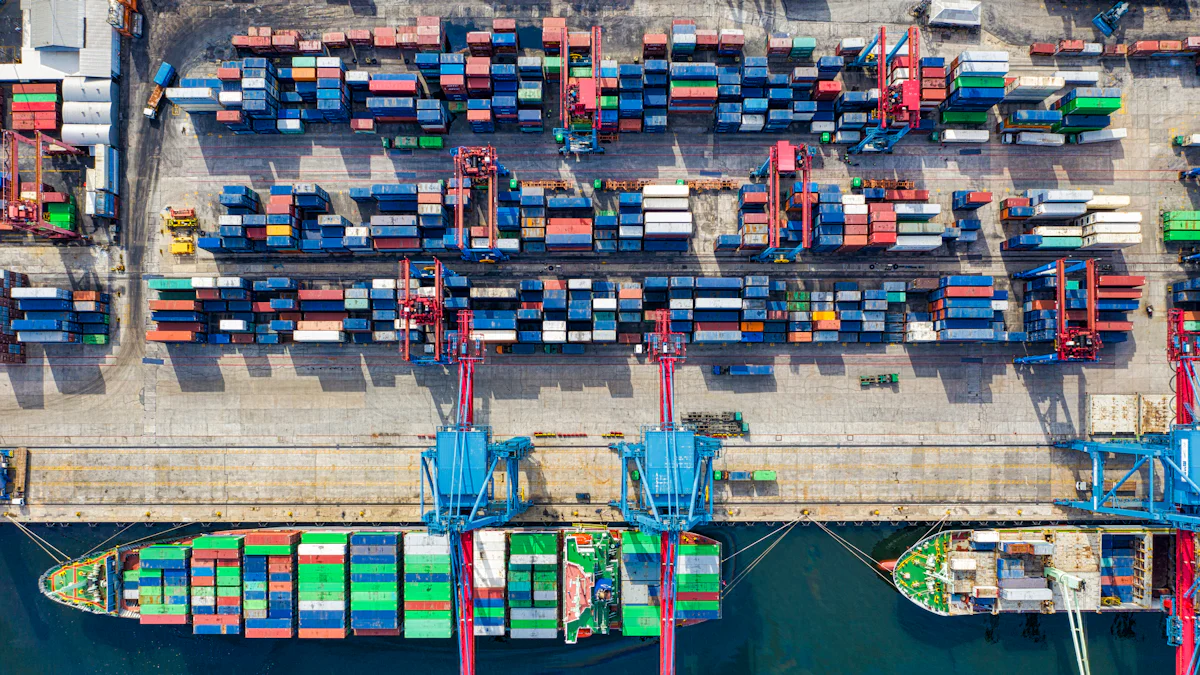Optimization and Intelligent Management in Viet Nam‘s Electronic Components Supply Chain

Supply chain optimization holds immense importance in the electronics industry. Vietnam plays a pivotal role in the global electronic components market. The country accounted for approximately 17.8% of the worldwide electronics market in 2023. Industry giants like Samsung and Foxconn have heavily invested in Vietnam's high-tech manufacturing facilities. These investments have driven significant growth in the sector. Intelligent management practices are crucial for enhancing efficiency and competitiveness within the Electronic Components Supply Chain. These practices include leveraging advanced technologies and data-driven decision-making to streamline operations.
Understanding the Electronic Components Supply Chain
Key Components of the Supply Chain
Raw Material Sourcing
Raw material sourcing forms the foundation of the Electronic Components Supply Chain. Vietnam relies on both domestic and foreign supply sources to meet the demand for raw materials. The country imports essential components from global markets. This approach ensures a steady flow of materials necessary for production. Efficient management of raw material sourcing reduces costs and minimizes delays. Companies must establish strong relationships with suppliers. This strategy helps in securing quality materials at competitive prices.
Manufacturing Processes
Manufacturing processes in Vietnam's Electronic Components Supply Chain involve several stages. These include assembly, testing, and quality control. Each stage requires precision and adherence to international standards. Companies implement advanced technologies to enhance production efficiency. Automation and robotics play a significant role in streamlining operations. These technologies reduce human error and increase output. Effective supply chain management ensures seamless coordination between different manufacturing stages. This coordination leads to timely delivery of finished products.
Distribution Networks
Distribution networks are crucial for delivering electronic components to global markets. Vietnam's strategic location offers a logistical advantage. The country serves as a hub for regional distribution. Companies utilize efficient supply chain strategies to optimize transportation routes. This optimization reduces transit times and lowers shipping costs. Advanced tracking systems provide real-time visibility into shipments. This visibility enhances customer satisfaction by ensuring timely deliveries. Distribution networks must adapt to changing market demands. Flexibility and agility are key to maintaining competitiveness.
Importance of Optimization
Cost Reduction
Cost reduction is a primary goal of supply chain management. Companies identify inefficiencies in manufacturing and distribution processes. Streamlining these processes leads to significant savings. Utilizing supply chain management software enhances visibility and control. This software identifies bottlenecks and removes redundant information. Companies achieve cost reduction through strategic planning and execution. Real-world examples demonstrate the effectiveness of these strategies. High-profile companies sustain cost-reduction efforts by focusing on continuous improvement.
Efficiency Improvement
Efficiency improvement is vital for maintaining a competitive edge. Supply chain plays a critical role in enhancing operational efficiency. Companies implement optimization techniques to streamline processes. These techniques include lean manufacturing and just-in-time inventory management. Real-time data analytics provides insights into supply chain performance. Companies leverage these insights to make informed decisions. Efficiency improvement leads to faster production cycles and reduced lead times. An efficient supply chain contributes to overall business success.
Competitive Advantage
Competitive advantage is achieved through effective supply chain management. Companies differentiate themselves by offering superior products and services. Supply chain plays a pivotal role in delivering value to customers. Companies focus on innovation and technological advancements. These advancements enhance product quality and customer satisfaction. Supply chain management strategies align with business objectives. Companies gain a competitive edge by adapting to market trends. Strategic partnerships with suppliers and distributors strengthen market position. A robust supply chain fosters long-term growth and sustainability.
Challenges in Vietnam's Electronic Components Supply Chain
Infrastructure Limitations

Transportation Issues
Vietnam faces significant transportation issues within the electronic components supply chain. The country's infrastructure struggles to keep pace with rapid industrial growth. Businesses encounter delays due to inadequate road networks and congested ports. These limitations hinder efficient movement of goods, affecting timely deliveries. Vietnamese businesses must navigate complex logistics to maintain competitiveness. The reliance on foreign inputs exacerbates these transportation challenges. Global disruptions further strain the supply chain, impacting Vietnamese businesses.
Technological Gaps
Technological gaps present another challenge for Vietnam's supply chain. Many businesses lack access to advanced technologies necessary for optimization. This gap hinders the ability to implement intelligent management systems. Vietnamese businesses often rely on outdated processes, reducing efficiency. The need for technological advancement is critical for maintaining a competitive edge. Businesses must invest in modern solutions to bridge these gaps. The integration of new technologies can enhance supply chain management in Vietnam.
Regulatory and Compliance Issues
Import/Export Regulations
Import/export regulations pose significant challenges for Vietnamese businesses. Strict compliance requirements increase complexity in the supply chain. Businesses face hurdles in navigating these regulations efficiently. Delays in customs clearance impact the timely delivery of electronic components. Vietnamese businesses must adhere to international standards to remain competitive. The reliance on imported raw materials adds to these regulatory challenges. Effective strategies are essential for managing these complexities.
Environmental Standards
Environmental standards also contribute to challenges in Vietnam's supply chain. Businesses must comply with stringent environmental regulations. These standards affect manufacturing processes and waste management. Vietnamese businesses face pressure to adopt sustainable practices. Compliance with environmental standards requires significant investment. The transition to greener operations presents both challenges and opportunities. Businesses that embrace sustainability gain a competitive advantage in the global market.
Strategic Solutions for Optimization
Implementing Intelligent Management Systems
Use of AI and Machine Learning
Artificial Intelligence (AI) and Machine Learning (ML) have transformed supply chain management. These technologies enhance decision-making and efficiency. AI improves supply chain visibility and optimizes production plans. Businesses can predict consumer demand accurately. AI-powered solutions reduce supply chain failures by 20% to 50%. This reduction leads to a 65% decrease in missed product orders. AI transforms operational responses into proactive initiatives. Companies gain a competitive edge through these advancements.
Real-time Data Analytics
Real-time data analytics plays a crucial role in supply chain management. Businesses leverage data-driven business management to make informed decisions. Real-time insights improve inventory tracking and management information systems. Companies use analytics to forecast future demand accurately. This capability enhances production management and reduces lead times. Data-driven strategies increase supply chain resilience. Businesses achieve greater efficiency and competitiveness through these methods.
Leveraging JUSDA for Supply Chain Solutions
Overview of JUSDA Services
JUSDA offers comprehensive supply chain solutions. The company integrates raw material procurement, manufacturing, and distribution. JUSDA excels in lean supply chain management. Advanced technologies like big data and IoT support complex customer demands. The JusLink platform provides real-time collaborative management systems. This platform enhances resource utilization and decision-making. JUSDA's global presence ensures efficient logistics solutions. The company operates 155 service points worldwide.

Case Studies of Successful Implementations
Several case studies highlight JUSDA's successful implementations. The JusLink platform supports intelligent supply chain management. Businesses achieve full-chain visibility and collaboration. JUSDA's services enhance supply chain competitiveness. Companies benefit from efficient resource utilization. JUSDA's innovative platforms streamline international trade. The JusTrade and JUSDA SR platforms empower cross-border retail supply chains. These solutions ensure reliable logistics and management strategies for Vietnamese businesses.

SMART JUSDA
Supply Chain Management Solution
Future Trends in Supply Chain Management
Digital Transformation
IoT Integration
The Internet of Things (IoT) plays a crucial role in the digital transformation of supply chain management. IoT devices enhance visibility across the entire supply chain. Sensors collect real-time data on inventory levels, transportation conditions, and equipment performance. This data enables businesses to make informed decisions quickly. IoT integration reduces operational costs by minimizing downtime and improving asset utilization. Businesses can predict maintenance needs and prevent equipment failures. IoT technology enhances supply chain efficiency and resilience.
Blockchain for Transparency
Blockchain technology offers significant benefits for supply chain transparency. This digital ledger system provides a secure and immutable record of transactions. Businesses gain complete visibility into the movement of goods from origin to destination. Blockchain ensures data integrity and reduces the risk of fraud. Businesses can verify product authenticity and traceability. This technology enhances trust among supply chain partners. Blockchain implementation improves compliance with regulatory requirements. Businesses achieve greater efficiency and accountability through blockchain solutions.

Sustainable Practices
Green Logistics
Green logistics focuses on reducing the environmental impact of supply chain operations. Businesses adopt eco-friendly practices to minimize carbon emissions and waste. Strategies include optimizing transportation routes and using energy-efficient vehicles. Businesses implement sustainable packaging solutions to reduce material usage. Green logistics enhances brand reputation and customer loyalty. Businesses gain a competitive advantage by aligning with environmental values. Sustainable practices contribute to long-term business success and resource conservation.
Circular Economy Models
Circular economy models promote resource efficiency and waste reduction. Businesses focus on designing products for durability and recyclability. Strategies involve reusing materials and components in new products. Businesses implement reverse logistics to recover end-of-life products. Circular economy practices reduce dependency on raw materials. Businesses achieve cost savings through resource optimization. These models support sustainable growth and environmental stewardship. Businesses align with global sustainability goals through circular economy initiatives.
Optimization and intelligent management are essential for Vietnam's electronic components supply chain. These practices enhance resilience and agility in a changing environment. Effective management provides a competitive edge by improving delivery speed and reducing costs. Vietnam faces challenges such as infrastructure limitations and regulatory issues. Strategic solutions like digital transformation and real-time data analytics address these challenges. The future outlook for Vietnam's supply chain is promising. Digital transformation will drive efficiency and sustainability. Supply chain management will continue to evolve, ensuring Vietnam remains competitive in the global market.
See Also
Optimizing High-Tech Manufacturing Supply Chain Solutions
Future-Proofing Logistics with AI Supply Chain
Maximizing Automotive Supply Chain Potential
